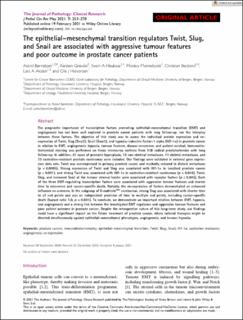| dc.description.abstract | The prognostic importance of transcription factors promoting epithelial–mesenchymal transition (EMT) and angiogenesis has not been well explored in prostate cancer patients with long follow-up, nor the interplay between these factors. The objective of this study was to assess the individual protein expression and co-expression of Twist, Slug (Snai2), Snail (Snai1), and hypoxia-inducible factor-1 alpha (Hif-1α) in prostate cancer in relation to EMT, angiogenesis, hypoxia, tumour features, disease recurrence, and patient survival. Immunohistochemical staining was performed on tissue microarray sections from 338 radical prostatectomies with long follow-up. In addition, 41 cases of prostatic hyperplasia, 33 non-skeletal metastases, 13 skeletal metastases, and 33 castration-resistant prostate carcinomas were included. Our findings were validated in external gene expression data sets. Twist was overexpressed in primary prostate cancer and markedly reduced in distant metastases (p < 0.0005). Strong expression of Twist and Slug was associated with Hif-1α in localised prostate cancer (p ≤ 0.001), and strong Twist was associated with Hif-1α in castration-resistant carcinomas (p = 0.044). Twist, Slug, and increased Snail at the tumour stromal border were associated with vascular factors (p ≤ 0.045). Each of the three EMT-regulating transcription factors were associated with aggressive tumour features and shorter time to recurrence and cancer-specific death. Notably, the co-expression of factors demonstrated an enhanced influence on outcome. In the subgroup of E-cadherinlow carcinomas, strong Slug was associated with shorter time to all end points and was an independent predictor of time to multiple end points, including cancer-specific death (hazard ratio 3.0, p = 0.041). To conclude, we demonstrate an important relation between EMT, hypoxia, and angiogenesis and a strong link between the investigated EMT regulators and aggressive tumour features and poor patient outcome in prostate cancer. Despite the retrospective nature of this long-term study, our findings could have a significant impact on the future treatment of prostate cancer, where tailored therapies might be directed simultaneously against epithelial–mesenchymal phenotypes, angiogenesis, and tumour hypoxia. | en_US |

